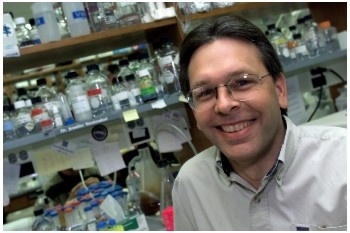Vanderbilt-Ingram Cancer Centerresearchers have uncovered another clue in the mystery of how chromosomal translocations cause acute leukemias.
Their findings suggest new treatment possibilities for these cancers of the bone marrow and blood.
In the October 26th issue of the Proceedings of the National Academy of Sciences, Scott W. Hiebert, Ph.D., professor of Biochemistry and Medicine, and colleagues report the molecular outcome of the most frequent translocation in acute myeloid leukemia (AML). The inv(16) translocation results in the production of a protein that collaborates to turn genes off, even when they should be turned on.
"This work really changes the paradigm for thinking about how this molecule works. And now that we know how it works, we can start thinking about potential therapies that block its action," Hiebert said.
Acute leukemia is a rapidly progressing disease and results in the accumulation of immature, functionless cells in the blood that interfere with the body's production of healthy blood cells. According to the Leukemia Society of America, 12,500 new cases will be diagnosed and some 7,900 persons will die from acute leukemia this year. About half of all acute leukemias are caused by chromosomal translocations, Hiebert said.
A chromosomal translocation happens when chromosomes--the structures containing genes--break and rejoin in a different way, creating new genes at the breakpoints. Think about breaking up a red stick and a blue stick, mixing up the pieces, and gluing them back together to make two new sticks. If the sticks were chromosomes, new genes would be created where red meets blue. Hiebert's goal has been to figure out what these new red-blue genes do, and how they participate in causing cancer.
The current work focuses on inv(16), the most frequent of several translocations associated with AML. Inv(16) happens when the middle section of chromosome 16 breaks and flips around--an inversion translocation.
The product of the new gene created by inv(16) alters the activity of a protein called AML-1. AML-1 is a transcription factor--a protein that turns other genes on and off. It is what Hiebert calls a "master regulator" because it controls major cellular pathways that participate in the proliferation, survival, and differentiation of blood cells.
The importance of AML-1 is underscored by the fact that its gene is one of the most commonly mutated in human leukemia. Translocations disrupting the AML-1 gene are associated with both acute myeloid and acute lymphocytic leukemias.
Whereas previous models held that inv(16) simply kept AML-1 from doing its job of turning genes on and off, Hiebert and colleagues now demonstrate that inv(16) joins with AML-1 to actively turn genes off, even those that AML-1 usually turns on.
It is likely that inv(16) recruits other proteins to help it force AML-1 to always turn genes off, Hiebert said, and possible treatments may hinge on the proteins that join it.
Based on other studies, one of these proteins might be an enzyme called histone deacetylase (HDAC). Hiebert and colleagues will now determine whether HDAC is part of the group working with inv(16).
"If HDAC is involved, then drugs that block its activity--HDAC inhibitors--might have an impact," Hiebert said. "We have these HDAC inhibitors, and they're being tried for other diseases. Our data suggest that they might provide effective treatment for AML."
In addition to determining what other proteins associate with inv(16), Hiebert is interested in defining the genes that are being turned off by the group. His preliminary data suggest that the complex is turning off tumor suppressor genes. Tumor suppressors protect against malignancy by sending threatening cells down a suicide pathway.
"The model for how translocations cause leukemia is then rather simple: translocation products turn off multiple tumor suppressors, and from there it only takes one or two more mutations to make a cancerous cell," Hiebert said.
Hiebert's colleagues Bart Lutterbach, Ph.D., a Fellow of the Leukemia Society of America, research assistant Yue Hou, and graduate student Kristie L. Durst participated in the studies. The work was supported by the National Cancer Institute, the National Institutes of Health, and the VICC.




